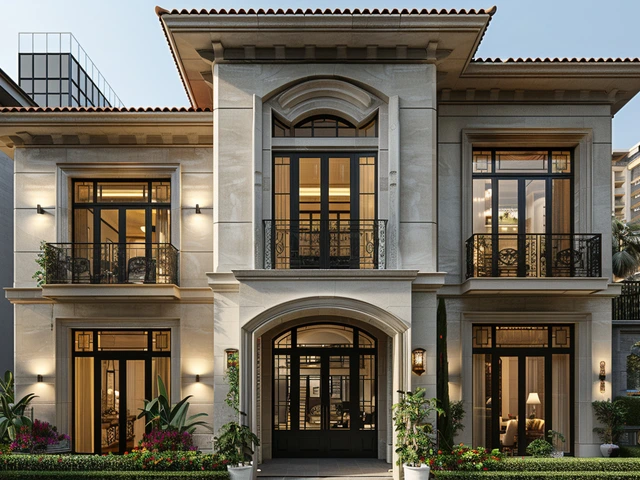The Birth of Georgian Architecture
As soon as you gaze upon a Georgian-style house, a sense of antiquity engulfs you. Their symmetrical allotment, paned windows, and stony structures immediately harken back to an era long vanished. Yet, their charm continues to persist, ever so bewitchingly, in our modern world. When it comes to architecture, I've often found myself drawn to the grandeur and timeless elegance of Georgian architecture. Its unique amalgamation of austerity and charm, of grandiose pomp and quiet simplicity has a certain allure that's hard to resist.
The Georgian style of architecture originated from the period of British history spanning the reigns of the first four Hanoverian kings of Britain, all named George, hence the name 'Georgian'. Times were changing swiftly during this era, and architecture was no different. This style represented a departure from the ornate and complex designs of the baroque and rococo, leaning towards simplicity, symmetry, and proportion. Keep reading: there's more. Did you know that one of the essential influences on Georgian architecture was the Roman architect Vitruvius, who had demanded beauty, stability, and utility in architecture? Amazing right!
The Core Design Principles of Georgian Architecture
Georgian architecture is all about balance. Symmetry, simplicity, and beauty in uniformity are the foundations of this style. The principles of Greek and Roman classicism were paramount, influencing everything from the pleasing proportions to the ornate pediments.
I remember an instance when Lydia, my wife, and I visited Bath, the Georgian city par excellence in England. Let me tell you, It was like stepping back in time. The uniformity of the buildings, the rhythmic repetition of windows, all paying homage to their classic roots, was a sight to behold. Who could resist the cookie-cutter terracotta facades lining manicured avenues, the iconic sash windows with twelve panes over twelve, or even the painted front doors crowning steps, often with a handy boot scraper nearby?
Examples of Iconic Georgian Buildings
There's a healthy smattering of iconic Georgian examples all across the globe, from the stately homes of England to the historical mansions of America's deep south. One can't deny the majestic allure of the Royal Crescent in Bath, where the signature Georgian architectural style truly had its heyday. Also, the White House in Washington, DC, is a perfect example of Georgian structure stateside. So, when in Rome, do as the Romans, but when in Bath or Washington, appreciate the Georgians!
Main Features of Georgian Architecture
Georgian architecture is distinctive and easy to recognize if you know what you’re looking for. The main attributes that are typical of Georgian architecture include sash windows, fanlights, large spacious rooms with high ceilings, among others. It's superfluous to say that these styles have found their way into the blueprints of architects and builders to this day. Wait till you hear this, though, our house in Wellington itself borrows a good deal of Georgian inspiration! I guess you could say our taste is, quite literally, 'classic'.
How to Decorate a Georgian-Style Home
Modern and Georgian styles can find common ground. The challenge lies in respecting the historical quality of the Georgian-style, while introducing modern aesthetics. Clashing styles can be visually jarring, but done right, boy, it’s harmony in the chaotic world!
Interiors of Georgian houses exude a certain stately dignity, yet they're anything but stiff or stuffy. They have been a design tradition for many centuries and continue today with great enthusiasm. Furniture, traditionally, was of a darker wood, but for a modern twist, many homeowners are opting for a lighter, more modern palette. Fabrics were rich but subtle with a preference for stripes, checks, and floral patterns. Interestingly, the Georgians were quite fond of wallpaper. Go funky with the wallpaper folks, it's historically accurate!
The Legacy of Georgian Architecture
The echo of Georgian architecture still resonates in our modern world. Architects, designers, and homeowners still borrow heavily from the aesthetic and value the uncluttered simplicity of Georgian design. It is without a shadow of a doubt that Georgian architecture has an enduring charm that impresses with its classic simplicity. The lingering impact of this elegant, clear-cut style is nowhere more evident than in the recent resurgence of neo-Georgian designs that have stolen the hearts of many.
The Timeless Elegance of Georgian Architecture
If you've kept up so far, you already know that the key to Georgian architecture's charm lies in its harmonious balance between simplicity and grandeur. The elegance and understated beauty of Georgian architecture are timeless, and while styles and tastes have continually evolved over the years, there's something about Georgians that keeps pulling us back. The perfect alignment, those elegant structures, the archetypal proportions - it feels right at home whether in the leafy alleys of Bath or the bustling streets of a metropolis.
As my reflections on this remarkable architectural genre conclude, I urge you to appreciate the deep historical roots of the Georgian era in the architecture around us. It's fascinating, isn't it? To realize how this robust old style flourishes in the heart of the modern world, reminding us that elegance never fades away, but rather, is a timeless tradition. So, let's raise a toast to The Timeless Elegance of Georgian Architecture, the remarkable silent narrator of our cities and towns.




